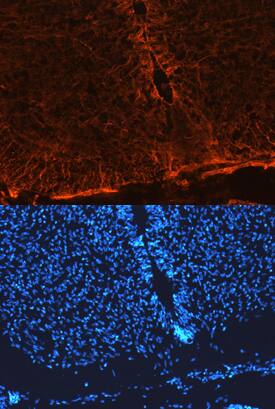Mouse Notch-1 Antibody
R&D Systems, part of Bio-Techne | Catalog # AF5267


Key Product Details
Species Reactivity
Validated:
Cited:
Applications
Validated:
Cited:
Label
Antibody Source
Product Specifications
Immunogen
Ala19-Gln526
Accession # AAM28905
Specificity
Clonality
Host
Isotype
Scientific Data Images for Mouse Notch-1 Antibody
Detection of Mouse Notch-1 by Western Blot.
Western blot shows lysates of bEnd.3 mouse endothelioma cell line. PVDF membrane was probed with 1 µg/mL of Mouse Notch-1 Antigen Affinity-purified Polyclonal Antibody (Catalog # AF5267) followed by HRP-conjugated Anti-Sheep IgG Secondary Antibody (Catalog # HAF016). A specific band was detected for Notch-1 at approximately 300 kDa (as indicated). This experiment was conducted under reducing conditions and using Immunoblot Buffer Group 8.Notch‑1 in Mouse Neural Tube.
Notch-1 was detected in immersion fixed frozen sections of mouse neural tube (E13.5) using Mouse Notch-1 Antigen Affinity-purified Polyclonal Antibody (Catalog # AF5267) at 10 µg/mL overnight at 4 °C. Tissue was stained using the NorthernLights™ 557-conjugated Anti-Sheep IgG Secondary Antibody (red, upper panel; Catalog # NL010) and counterstained with DAPI (blue, lower panel). View our protocol for Fluorescent IHC Staining of Frozen Tissue Sections.Applications for Mouse Notch-1 Antibody
Immunohistochemistry
Sample: Immersion fixed frozen sections of mouse neural tube (E13.5)
Western Blot
Sample: bEnd.3 mouse endothelioma cell line
Formulation, Preparation, and Storage
Purification
Reconstitution
Formulation
Shipping
Stability & Storage
- 12 months from date of receipt, -20 to -70 °C as supplied.
- 1 month, 2 to 8 °C under sterile conditions after reconstitution.
- 6 months, -20 to -70 °C under sterile conditions after reconstitution.
Background: Notch-1
Notch-1 is a 300 kDa type I transmembrane glycoprotein that is one of four Notch homologues involved in developmental processes (1‑3). Notch signaling is important for maintaining stem cells and inducing differentiation, especially in the nervous system and lymphoid tissues (2‑4). Notch can specify binary cell fates. For example, it promotes T-cell over B-cell development from a common precursor (2). Mouse Notch-1 is synthesized as a 2531 amino acid (aa) precursor that contains an 18 aa signal sequence, a 1707 aa extracellular domain (ECD) with 36 EGF-like repeats and three Lin-12/notch repeats (LNR), a 21 aa transmembrane (TM) segment and a 785 aa cytoplasmic domain that contains six ankyrin repeats, a glutamine-rich domain and a PEST sequence. The 11th and 12th EGF-like repeats, that bind ligands such as Jagged and Delta-like families in humans, correspond to aa 412‑488 in mouse Notch-1 (6). Elongation of O-linked fucose chains by Fringe family members at a site within this region can inhibit the interaction of Notch with Jagged ligands, thereby promoting Delta-like ligand interactions (7). The Notch-1 receptor undergoes post-translational furin-type proteolytic cleavage, generating a heterodimer through the interaction of a hydrophobic area C-terminal to the LNR on the extracellular region with the transmembrane/cytoplasmic portion (8, 9). Upon ligand binding, additional sequential proteolysis by TNF-converting enzyme (ADAM17) and the presenilin-dependent gamma-secretase results in the release of the Notch intracellular domain (NICD) which translocates into the nucleus, activating transcription of Notch-responsive genes (10). Mouse Notch-1 ECD aa 19‑526, which includes the first 13 EGF repeats, shows 94%, 91%, 86% and 79% aa identity with corresponding regions of rat, human, canine, and chicken Notch-1, respectively. This region also exhibits 55‑58% aa identity with human Notch-2 and Notch-3.
References
- Ellisen, L.W. et al. (1991) Cell 66:649.
- Dumortier, A. et al. (2005) Int. J. Hematol. 82:277.
- Yoon, K. and N. Gaiano (2005) Nat. Neurosci. 8:709.
- Androutsellis-Theotokis, A. et al. (2006) Nature 442:823.
- Weng, A.P. et al. (2004) Science 306:269.
- Hambleton, S. et al. (2004) Structure 12:2173.
- Yang, L. et al. (2005) Mol. Biol. Cell 16:927.
- Sanchez-Irizarry, C. et al. (2004) Mol. Cell. Biol. 24:9265.
- Logeat, F. et al. (1998) Proc. Natl. Acad. Sci. USA 95:8108.
- Mumm, J.S. and R. Kopan (2000) Dev. Biol. 228:151.
Alternate Names
Gene Symbol
UniProt
Additional Notch-1 Products
Product Documents for Mouse Notch-1 Antibody
Product Specific Notices for Mouse Notch-1 Antibody
For research use only
